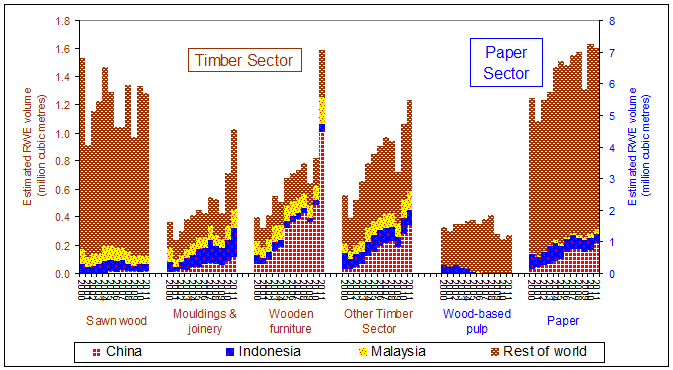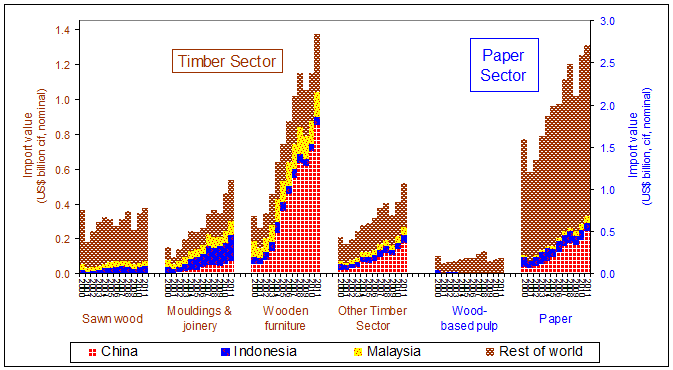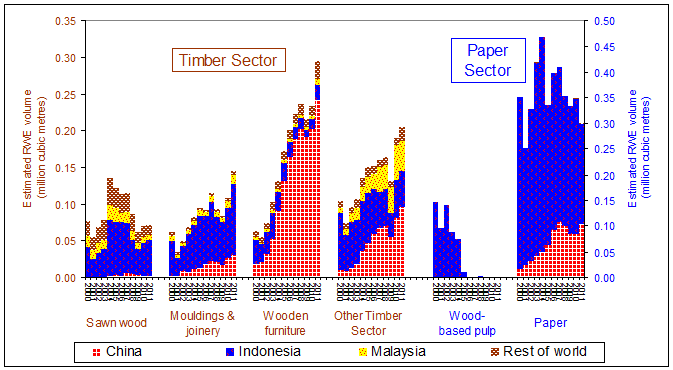|
|
||
|
Australia After years of procrastination Australia is likely by the end of 2012 to prohibit the import of illegal wood-based products. As with the USA's amended Lacey Act and the EU's Regulation 995/2010, the prospective legislation in Austalia is likely to require that those who place wood-based products on the Australian market carry out due diligence in order to minimise the risk that these products are associated with illegality. In doing so, the legislation would oblige the wood-based products sector to improve the quality of its supply chains to levels prevalent in other sectors, for example processed food and vehicles. The following charts illustrate trends in Australia's imports of wood-based products and probable trends in their illegal content. The only formal evaluationRef of those illegal imports concerned a single financial year - 2003/2004. However, the authors of that evaluation seem to have adopted the percentages of illegality which others had suggested for potentiallly different contexts. Nevertheless, the estimates illustrated below do not differ greatly from those in that evaluation, except in relation to paper. The UN Comtrade database was used as the source of trade data, revisions being made where data for physical quantity are not provided by the source. Typically, roundwood equivalent volume was estimated from the data for physical quantity by multiplying by - in cubic metres per cubic metre - 1.8 (sawn wood), 1.9 (mouldings), 2.3 (plywood) or - in cubic metres per tonne 2.8 (wooden furniture), 3.5 (joinery and paper), and 4.5 (wood-based pulp).Ref The illegal content for each bilateral flow for each year and product was individually assessed bearing in mind, for example, that rubberwood furniture from Malaysia and pine plywoodRef from Papua New Guinea are much less likely to be illegal than tropical plywood from Sarawak and tropical logs from Papua New Guinea, that a new mill producing tropical plywoodRef seems to have recently started operating in Papua New Guinea and that the export of sawn wood from Indonesia is prohibited if this derives from forest (as distinct from plantations / tree farms). One might conclude from the lower two charts of the four below that, for the last few years, the total roundwood equivalent volume and import value of Australia's annual imports of illegal wood-based products have been in the order of one million cubic metres and US$ 500 million respectively. However, the apparent stability of the totals mask the trends in illegal imports of specific products. Changes in import value are less salient than changes in roundwood equivalent volume - the latter being unaffected by changes in unit price, exchange rates, and the mix of products. Concerning illegal imports of paper, increasing supplies from China might have offset reduced imports from Indonesia - despite the probability that the former is made at least partly from pulp milled in Indonesia and/or is supplied by affiliates of at least one of the two leading pulp milling groups operating in Indonesia. Understandably, Australia no longer imports wood-based pulp from Indonesia China accounts for most of the probable increase in imports of illegal Timber Sector products, particularly as wooden furniture. However, "mouldings" from Indonesia account for most of the illegal mouldings & joinery which Australia probably imports. Also, Indonesia and Sarawak account for a greater volume of Australia's probable imports of illegal plywood than China. Plywood comprises most of the "Other Timber Sector" products which Australia probably imports. Users may "click" here in order to download a simple spreadsheet file which will automatically determine and chart estimates of the total roundwood equivalent volume and import value of Australia's imports of illegal paper from Indonesia if users adjust the data highlighted in cream colour. The percentages already inserted in cream colour are not necessarily appropriate. However, this method of assessment is probably more robust and requires greater understanding of the realities than other methods. Click here for insights into illegality concerning Indonesia's paper and timber sectors. Australia's imports of wood-based products (RWE
volume basis)
Australia's imports of wood-based products (import
value basis)
Estimates of Australia's imports of illegal wood-based
products (RWE volume basis)
Estimates of Australia's imports of illegal wood-based
products (import value basis)
|
||
|
|
||




